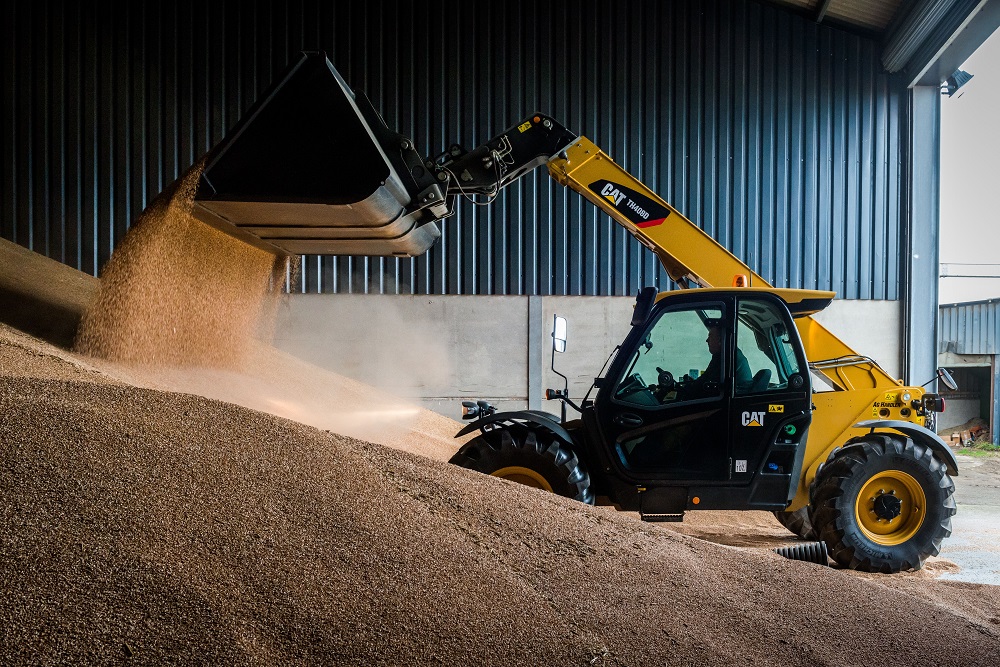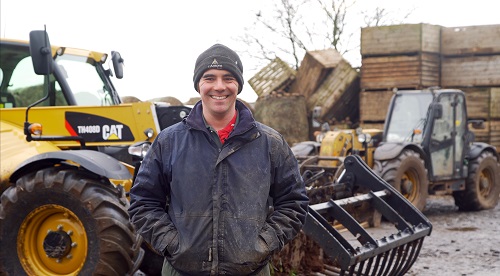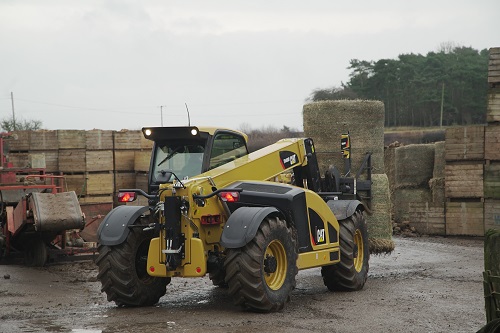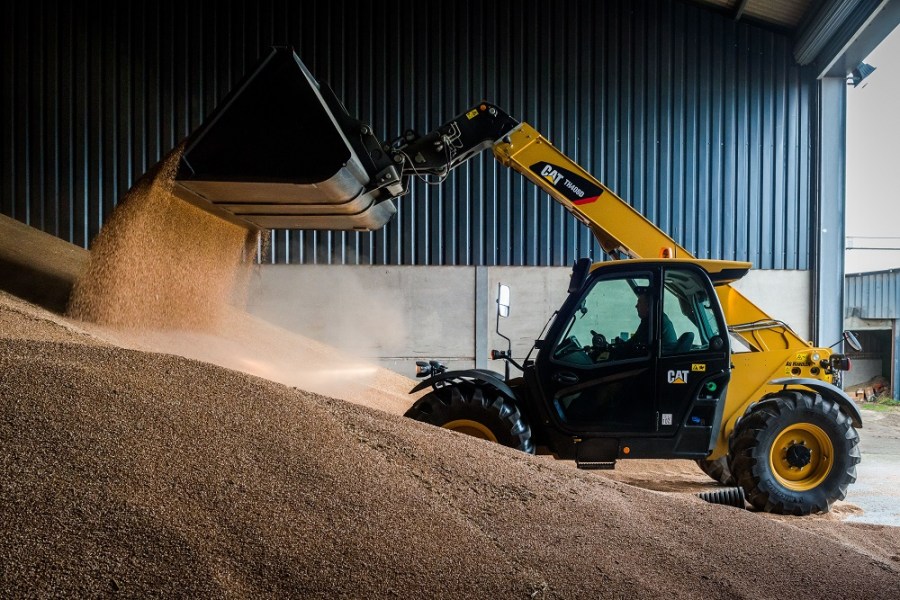
With thoughts of changing his telehandler, a Yorks farmer had the chance to put the latest Cat TH408D through its paces for a few weeks this spring. CPM sought his verdict on Caterpillar’s flagship model.
Everything that comes on to the farm arrives or leaves via a materials handler – you just need them all the time.
By Jane Brooks
Yorks farmer and contractor Chris Heslop currently runs a 2009 Cat TH407C, which has been on the farm from new and is edging towards 11,000 hours.
A second Caterpillar TH336C has done 8400 hours and it’s on a 63 plate. It’s on its second set of tyres, which with 3000 hours on them, look to be coming up to replacement again.
At the beginning of this year an enquiry about changing his TH407C led to local dealers Park Farm Machinery of Aberford, Leeds offering Chris Heslop the chance to have their latest demo model – the new and upgraded Caterpillar TH408D – for a few weeks trial on the farm.

Compared with the older TH407C, Chris Heslop was very impressed with the additional lift height and improved visibility from the new model.
Based at Crosper Farm, Spofforth near to Harrogate in North Yorks, Chris Heslop and his family farm 400ha of their own land, having a truly mixed enterprise, together with their own on-farm grain storage. They also have an agricultural contracting business providing a stubble-to-stubble service over a further 400ha of arable land.
On the arable side this year they’re cropping 40ha of potatoes, 120ha winter wheat, 40ha winter barley, 24ha acres of spring barley, 40ha of oilseed rape, 36ha of sugar beet, 20ha of fodder beat and around 20ha of beans.
“With the beans, OSR, potatoes and sugar beet as break crops, we don’t have much of a blackgrass burden, but it’s getting about and we’re very mindful to keep on top of it at all times,” he notes.

The new Caterpillar TH408D agricultural telehandler had its official UK launch at this years LAMMA show.
“We run Case and Fendt tractors and we’ve recently started growing sugar beet again. So we’ve just brought a Väderstad Tempo V mounted precision drill mainly because of the sugar beet, it’s GPS linked, which we’ll be using for the auto-shutoff so we don’t double drill on headlands.”
Although the drilling tractor is equipped with Topcon GPS, they don’t currently variable-rate apply any fertiliser – the spreader is a KRM Bredal. “Our sprayer is a 24m self-propelled Bargam with section control. It’s just coming into its third season and is the second Bargam we’ve had.”
There’s also a further 240ha of grassland, which supports the farm’s single-suckler herd together with their sheep dairy enterprise, consisting of a flock of 400 Friesland ewes, which are milked twice daily. It’s pretty much a closed flock as the Heslops breed all their own replacements and currently have around 700 sheep in total.
“With the mixed farming enterprise at home, as well as the agricultural contracting business, both the Caterpillar telehandlers at Crosper Farm have been well worked. Basically, everything that comes onto the farm arrives or leaves via a materials handler and you just need them all the time. So we decided to look at swapping the TH407C for a new TH408D,” explains Chris Heslop.
The Heslops’ 2009 Caterpillar TH407C is an early model as they were first launched in 2008 as a replacement for the Caterpillar TH330B. Its rated lift capacity is 3700kg and at full stretch its maximum lift height is 6.1m.
The new Caterpillar TH408D agricultural telehandler had its official UK launch in Jan at this year’s LAMMA show. It has a rated lift capacity of 4t and a maximum lift height of 7.6m; it also has an impressive 2025kg capacity at maximum lift height.
Compared to the older TH407C, Chris Heslop was very impressed with the additional lift height. “There’s an extra metre of reach, but compared to our TH407C it wasn’t at all noticeable in operation, it was still just as nimble and there was no numbness in its handling at full reach. It’s very well balanced and easy to manoeuvre. Also because you’re sat up higher, visibility is far better than on the older model.”
The Heslop’s 2009 model has a five-speed Powersynchro transmission, with automatic shift between 4th and 5th gears, but in 2012 Cat’s C-series machines were given a revamp when they were fitted with a new Caterpillar powershift six forward, three reverse speed transmission, giving a forward speed of 40km/h.
At the same time, hydraulic performance was also boosted, by fitting a torque-regulated 150 litre/min load-sensing pump. Some of the earlier models had a few cooling problems and this was also remedied in 2012 by fitting a larger cooling pack with a hydraulically powered reversible fan.
Another update was to move the powershuttle and gear change control, these are carried out using a steering column mounted shuttle on the Heslop’s model, but from 2012 this was changed to joystick control, the new TH408D still has these features.
2017 upgrades to the cab include a new ergonomic control layout on the dash and a new LED display with fuel and speed readings.
The low boom-pivot point and elevated cab along with the curved profile of the bonnet have improved visibility. Six standard work lights provide illumination for low-light working conditions. An optional rearview camera and peripheral sensors are also available.
An in-cab advanced display system is also available, giving access to machine information, including load charts, maintenance schedules and rearview-camera images. It also allows setting hydraulic response levels, driving modes, and reversing-fan intervals.
When selecting different work tools, the display shows the appropriate load charts. A keypad security code system to immobilise the machine is also a useful deterrent against theft.
Available also is a ride-control system that dampens boom movement when traveling in rough terrain at speeds exceeding 5km/h, as well as an intelligent boom-suspension system that allows the boom to automatically follow the contour of the terrain, preventing work tools from scraping the ground.
Chris Heslop remarks that the layout of the cab is a little different to the TH407C, particularly the position of the joystick, “I like the multi-function joystick, you can do everything with the joystick apart from the steering.
“It still has the two settings for hydraulics as on the other machine – slow speed for accurate work and a faster speed for muck loading or suchlike. It didn’t have a reversing camera, although I understand they’re available as an option. But all in all, the cab’s a nice working space.”
The engine on the older TH407C is a turbocharged Cat C4.4 Acert rated at 100hp, although 126hp was also available as an option. Back in 2009 the engines met stage IIIA emissions regulations (non Adblue).
On the new TH408D the engine is still a Caterpillar C4.4 Acert, but it now meets stage IV emission standards. The standard version is offered with an 112hp engine with optional upgrades to either 126hp or 144hp.
“The 144hp engine is certainly a step up – it has plenty of power. It uses Adblue, but then most tractors and handlers are on it now and there was no problem with it, although personally I don’t really like Adblue.
“We used it with the grain shovel and it easily handled 2.5t. We also tried it with the pallet forks, gave it a go loading manure with a muck grab into the muck spreader, put the bale handler on it for a while and also fitted it with a box tickler for tipping potato boxes.”
The Heslops’ test machine was fitted with Michelin 500/70 R24 XMCL tyres, which are available as an option. The standard offering for the Ag Handler models in the UK is the 460/70R24 Michelin XMCL. With the option of 500/70 R24 XMCL or 460/70 R24 Michelin Bibload. A standard manual or optional hydraulic quick coupler are available, both with a Cat “IT” interface. Alternative couplers are a Caterpillar factory option.
“We certainly put it through its paces. It did a lot of muck-spreader loading, because it just happened to be here at the time we were spreading a lot of in early spring. There were a couple of teething problems on the drop of the boom but the Caterpillar technicians soon sorted it out.
“Actually we tried everything with it, moving potatoes out the store, shifting grain, moving bales and I was pretty impressed with its all round handling and the extra length on the boom.
“In fact, we’re very interested in it, they did offer it to us, but it just hasn’t come to fruition yet. Originally we intended to swap our old TH407C for the new TH408D, but now think we may keep it, as really we’re getting towards needing a third machine on the farm.”
Telematics technology links in the material handler
Caterpillar is very much part of the industrial ‘Internet of things’, having introduced ProductLink remote monitoring several years ago. This type of telematics technology has been utilised within the heavy construction industry for some time, but also can be of benefit to agricultural operators.
Information, such as events and diagnostic codes as well as hours, fuel levels or idle time are transmitted via cell signal and satellite to a secure web-based application called VisionLink, which is powered by Trimble. This enables customised condition and utilisation reports, enhanced mapping functionality and mixed-fleet capabilities.
Agricultural telehandlers such as the TH408D should be ProductLink ready, with a subscription to VisionLink available to help track machine location and trigger servicing intervals.
VisionLink also allows you to quickly and easily view all of your equipment, regardless of make, allowing insight into the operation, health and productivity. Providing data such as working and idle hours, fuel consumption, start and stop times and more, while event and diagnostic codes are provided from a variety of electronically controlled systems.
VisionLink also allows additional features for Cat equipment through integration to other Caterpillar data and applications such as online parts ordering and fluid analysis results.
Older machines and other equipment can also be retrofitted with ProductLink. Typically machines manufactured within the past 10 years have electronically controlled systems that enable use of a broader collection of ProductLink features.
Information from VisionLink can usually be shared with other business systems via a data feed service that allows information that’s remotely reported from equipment to be integrated into business applications.
Updates to the system during the last year have added Bluetooth connectivity together with a complete redesign of VisionLink. This incorporates a number of refined features, including easy-to-read and navigate screens whether using a phone, tablet, notebook or desktop.
Whereas the legacy VisionLink had separate desktop and mobile versions, the new version of VisionLink incorporates a responsive design to ensure users experience a more intuitive transition between mobile and desktop user interfaces.
The new version also includes a suite of apps enabling the customer to select a view and information based on the user’s role or task needing to be performed.
Theses apps can be easily accessed for quick reference and easy viewing. For example, equipment or fleet managers can access data related to asset hours, location and utilisation without having to sort through extraneous information, such as fault codes, maintenance schedules or productivity information that may not pertain to their responsibilities.
When the rollout is complete, the new VisionLink will offer a service layer called the VisionLink Services Platform which enables partners and third parties to extend the VisionLink products to fit their unique needs.
Existing features have been moved into new apps, a single sign-on to all apps, ability to move back and forth between apps easily and all existing features are available in the VisionLink Legacy app. The new and the legacy format will co-exist for a time until all relevant features are completely migrated.
Farm facts
TH Heslop and Sons, Crosper Farm, Spofforth, Harrogate, North Yorks
- Farmed area: 400ha farmed plus 400ha stubble-to-stubble contracting services
- Cropping: Winter wheat, winter barley, spring barley, OSR, potatoes, sugar beet, fodder beat, beans
- Agronomist: John MacFarlane, Arable Alliance
- Soils: Sand through to heavy clay, sandstone, limestone
- Tractors: 2x Case Puma 160; Puma 200; Puma 215; Case Maxxum 125; Fendt 720, 826, 514
- Telehandlers: Caterpillar TH336C, Caterpillar TH407C
- GPS: Topcon
- Combine: John Deere, Case IH Axial Flow, Claas Dominator
- Cultivator: HE-VA trailed tine cultivator
- Plough: 2x Kuhn 4f
- Sprayer: Bargam 24m self propelled
- Fertiliser spreader: KRM Bredal
- Muck spreader: 8t Triffitt rear discharge
- Staff: Five full time, seasonal labour and a student.




